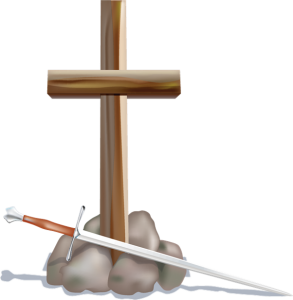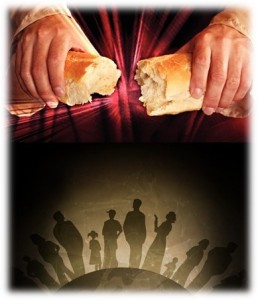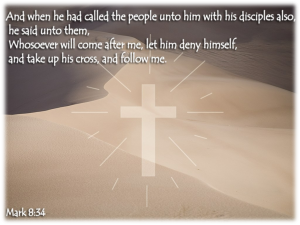MARK 8: WHO’S JESUS?
If you’ve been following my Breadcrumbs, you may remember that in my 13 March Breadcrumb, Jesus  said something weird: “Do not think that I came to bring peace on the earth; I did not come to bring peace, but a sword.” Then, using a quote from the ancient prophet Micah, He went on the say: “For I came to set a man against his father, and a daughter against her mother, and a daughter-in-law against her mother-in-law; and a man’s enemies will be the members of his household.”[a] If this is true, then it shouldn’t be surprising that any mention of Him divides.[b]
said something weird: “Do not think that I came to bring peace on the earth; I did not come to bring peace, but a sword.” Then, using a quote from the ancient prophet Micah, He went on the say: “For I came to set a man against his father, and a daughter against her mother, and a daughter-in-law against her mother-in-law; and a man’s enemies will be the members of his household.”[a] If this is true, then it shouldn’t be surprising that any mention of Him divides.[b]
Today’s chapter can be divided into three parts:
the story of the bread [v1-21];
the story of the blind [v22-30];
and the story of the brave. [v31-38]
But to begin, we need to remember that nothing in the Creator God’s epic story line is random. Everything is connected within a very complex tapestry that He is weaving. So, the first story about bread, in today’s chapter, isn’t just a nice little story to read to your children at bedtime. This is an incredibly important moment in documented history, where the Creator God begins to “join the dots”.
The Story of the Bread
Almost two millenniums earlier, Father God had compassion on His people. At that time, He provided in excess of 600,000 fighting men with bread – not counting the elderly, the women, and the children. In reality, this would mean more like 2 million people, and He provided this manna every day for 40 years.[c] It is little wonder then, that His Son would also have compassion to feed His sheep. [v2-3] The seven loaves [v5] and the seven basketfuls [v8] are signs for the Jews involved, that their Creator (who often does things in 7s) is behind this good work.
If they missed that clue, the ancient prophet Elisha had in the past, miraculously fed 100 men with 20 barley loaves because the Creator God said, “They will eat and have some left over.”[d] The fact that HIStory was repeating the phenomenon with 40x the power in Jesus, should have “screamed out” who He was.

Breaking the bread and giving thanks [v6], is a symbol that dates back even further to the days of Melchizedek, King and Priest of Salem (Jerusalem), when Abraham was alive.[e] It’s a thread in the Creator God’s epic storyline that runs through the Manna of the Exodus, the Bread of the Presence[f] and on to the event of Jesus death – the Bread of Life who was personified and then broken for us.[g] With that, the first part of this chapter ties into the last part of this chapter. But for now, it’s enough to know that Father God feeds those who come out of their way in search of answers from Him.[h]
Having said that, our Maker has the ability to judge the thoughts and attitudes of our hearts[i] – those in genuine need and those fixated on the spectacular. Unless there’s proof, by way of something extraordinary, then the latter won’t believe:
“Why does this generation ask for a sign? Truly I tell you, no sign will be given to it.” [v12]
Using the analogy of yeast in bread, Jesus warned His followers not to be influenced and “contaminated” by the spread of this sort of thinking from so-called religious leaders and rulers that demands “seen proof”, because it stops us from being able to see with our hearts. [v15] These were the people whose own Law told them that there was only a need for two or three witnesses to make something fact.[j] And yet, they weren’t satisfied with the widely spreading story about Jesus from the 4,000 that He’d just fed! They needed to see proof themselves, through the miraculous. Simple faith, while uncovering signs, clues and pointers within God’s Word seemed to be too much hard work. [v19-21] So, the second part to today’s chapter follows on from people who are “blind to the obvious”.[j]
The Story of the Blind Man
The underlying problem of not being able to see the truth in Jesus’ identity was dramatized in the story of a blind man. [v22-30] With more miracles related to blindness, I wondered if it was simply because there were more blind people back then. Could it have been because this is a more spectacular miracle and more “news worthy”, or is there something more – the story behind the story? For one thing, Jesus didn’t act like He was looking for news headlines. He told the blind man to head straight home and not return to the crowd. [v26] I think the clue to this story relates to what happened before and after.
Just like the religious leaders, Jesus’ disciples had the physical ability to see, but they couldn’t “see who Jesus was” – having eyes to see but not able to understanding. [v17-18] We need to understand that this epic drama isn’t a fairy tale filled with nice children’s stories about hungry people eating, and blind people seeing. It’s an imperative life-and-death road map for us.
The Story of the Brave
Once His followers understood who He was [v29], Jesus immediately told them plainly why He came [v31], and what’s expected of us [v34-38] – and none of it is for the faint-hearted. Jesus immediately started to lose His following when the future was spelt out.[k] But, you may remember from my 13 March Breadcrumb, that Jesus said unless we also take up our cross and follow Him, we’re not worthy of Him.[l] In other words, HIStory has always been a story of the brave who’ll stand firm to the end.[m]
– and none of it is for the faint-hearted. Jesus immediately started to lose His following when the future was spelt out.[k] But, you may remember from my 13 March Breadcrumb, that Jesus said unless we also take up our cross and follow Him, we’re not worthy of Him.[l] In other words, HIStory has always been a story of the brave who’ll stand firm to the end.[m]
So while the world is still divided over the question: Who really was/is Jesus? I’ve moved on. I’m interested in something far more important than identity alone: What did Jesus come for and what’s my response to my Maker’s Global MasterPlan that He achieved by sending Jesus? So, just as Jesus’ future was mapped out at least 700 years before He came[n], my future has also been made clear now for 2,000 years…
Jesus said: “What good is it for someone to gain the whole world, yet forfeit their soul? Or what can anyone give in exchange for their soul? If anyone is ashamed of me and my words in this adulterous and sinful generation, the Son of Man will be ashamed of them when He comes in His Father’s glory with the holy angels.” [v36-38]
CLICK to return to today’s “Daily Breadcrumbs”
[a] Matthew 10:34-36 See also Micah 7:6
[b] Hebrew 4:12
[c] Exodus c16
[d] 2 Kings 4:42-44
[e] Genesis 14:18
[f] Exodus 25:30
[g] John 6:25-31 and Matthew 26:26 and Luke 24:30-35
[h] Isaiah 55:1
[i] Hebrews 4:12
[j] Deuteronomy 17:6 & 19:15
[k] Isaiah 6:9
[l] John 6:66-68
[m] Matthew 10:38
[n] Revelation 21:8
[o] Isaiah c53